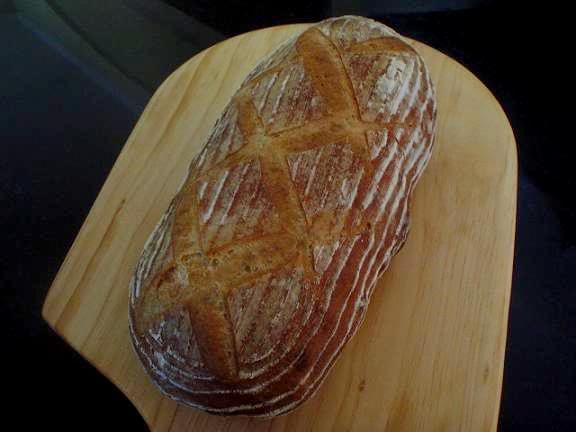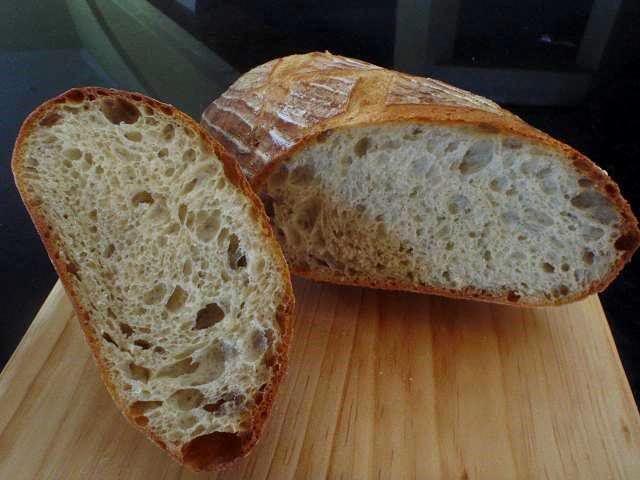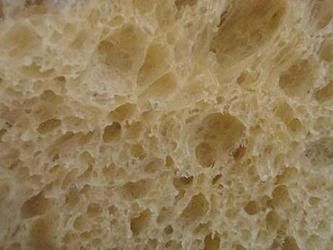
James J MacGuire's Pain de Tradition
Many TFL users would recognise Mr James J. MacGuire's name as he is the technical editor for Prof. Raymond Calvel's "The Taste of Bread." In a 10 page article entitled, "The Baguette" in the Winter 2006 issue of Mr Edward Behr's quarterly magazine "The Art of Eating," ie. No 73+74 issue, Mr MacGuire's message about a good French traditional bread is very clear: slow & gentle mixing with autolyse, long fermentation, and high hydration.
A 4-page formula follows The Baguette article in the same issue and is entitled "A Full-Flavored, Minimum-Kneading, All-Included Recipe for a Round Loaf with Many of the Advantages of the Baguette." This is an old-style straight-dough formula which is superhydrated and can also be used for baguette. My understanding from reading the article is that the method in the formula is like that applied in Prof. Calvel's younger days. I made my bread using Mr MacGuire's formula in the magazine and I called it "James J MacGuire's Pain de Tradition" which may not be entirely accurate but it is how I understood it to be. I would strongly encourage any one who is interested in Mr MacGuire's detailed formula to have a look at his well-written article in the Art of Eating magazine. As a home baker, I can finally say that I have found a method that I can rely upon with consistent result, and I thank Mr MacGuire for making the formula available to home bakers as well as Mr Behr's for publishing such a quality magazine.
As Mr MacGuire says in Prof. Calvel's "The Taste of Bread" that bakers have always been known for their desire to form friendships and for their willingness to share, to me no sharing is as useful as pointing to the right direction. I first learnt about the MacGuire's article through the Q & A with Daniel T. DiMuzio when Floyd and Eric interviewed Mr DiMuzio back in May this year. If Mr DiMuzioh had not mentioned about it, I would not have known about Mr MacGuire's recipe.
The following is the bread that I made based on Mr MacGuire's formula:



When it came out of the oven, it sang for the best part of 6 to 7 minutes. There was a very strong nutty aroma in the crust. The crumb was a beautiful creamy color; it's light and delicate to taste.
Shiao-Ping


Comments
Thank you for this recipe and what a wonderful write-up...Your loaf is gorgeous! I will have to make this bread..it sounds wonderful! I would like to know did you line your basket with linen and flour or just flour it?
Sylvia
I just floured my banneton with this one. If you use linen, you will need to four it first; with either case MadGuire warns not to use too much flour for dusting as too much coating will hinder browning and crispness of the crust. I am always at risk of dusting too much flour as I am scare of dough sticking to the sides of my basket, especially given that this is such a wet dough (but very manageable).
Shiao-Ping
Shiao-Ping,
Your breads are always so beautiful, and thank you for such a clear write up and the tidbits of history and tradition before the method. Very informative.
Can you tell me, do you have a method of maintaining an environmental temperature for your doughs to ferment &/or proof in? "Room temperature" is such a vague term...
Thanks for any info,
:-Paul
Hi Paul, I was just thinking about the same thing actually. Because our Queensland winter is very mild, my kitchen temp is always around 19 - 21C (66 - 70 F) which is almost perfect for the dough (In New South Wales where Sydney is and where I once lived, the winter temp is at least 3 - 5C lower). In the rare event where temp drops below that range, what I do is to place my dough in the sunny part of my balcony for up to 1/2 hour at a time to warm the dough up.
There had been a lot of discussion about proofing box at TFL in the past; if you do a search, you may find some very clever ways to achieving the temp you want. The easiest that I've found is just to heat up a glass of water in the microwave and let the hot steam from the boiling water warm up the little area of the microwave, THEN, place the covered dough in there. But sometimes this is a trap because if the temp is too high, the fermentation goes too fast and the dough quality suffers.
I think my problem will be in summer - our summer is notoriously hot. MacGuire says in the old days in France they used to mix in ice cubes with the water to bring the dough temp to manageable levels in summer.
Hope this helps.
Shiao-Ping
Yes, Shiao-Ping. Thanks for the excellent write up on Macguire. Your bread looks very nice. I'm sure your sisters will be able to duplicate it. Too bad Macguire has now given up bread and gone on Atkins (just kidding :-) ).
--Pamela
His restaurant in Montreal (which had a bakery) was called Le Passe-Partout. My good friend the Chinese musician Liu Fang live in Montreal with her husband. I would definitely have told Liu Fang about it had it still opened. Too bad.
Aparently he does bread seminars for The American Institute of Baking, The Culinary Institute of America, and The American Breadbakers' Guild and contributes articles and cookbook reviews to Ed Behr's The Art of Eating.
Shiao-Ping
Thanks for sending the link to the music. I listened to it and it was very nice!
Dan DiMuzio mentioned Macguire awhile back so it was great that you brought him up again.
http://www.thefreshloaf.com/node/11891/q-amp-daniel-t-dimuzio
--Pamela
Thanks Shiao-Ping for your post.
Excellent bread; it took me a better part of the day but well worth it.
It may be tough to get a water temperature of 44 degrees F as per the formula as it is 29 degrees C in the house at the moment but ice water does the trick.
Yes, the dough is slightly liquid to handle and yes again, it did stick a little to the cloth of the brotform but the bread is great in taste with excellent crust and good airy crumb.
Will definitely be one of our favorites.
Best
Stefan
Hi Stefan
I am so glad to hear that it worked for you. Sometimes what works for other people may not always work for us. It takes just little changes and the whole thing may be completely different. Well, I am so happy to hear that you have good result.
Shiao-Ping
So maybe it's good that our 500' deep well in Fox, Alaska produces 38 F water, eh? Heh heh... I love Shiao-Ping's clear and precise write-ups. Obviously an intelligent and skilled woman who loves to bake, and is an artist at heart. I will be trying this bread soon... I appreciate the post very much.
Brian
nice post. i live in montreal and i heard of le passe-partout altho i wasn't aware that it had closed. i'll google it - perhaps he sold the business and the new owner retained the old name?
nice loaf!
I just ate from the loaf I made following this recipe. I made it from rye starter and with about 73% hydration so it came out a bit more dense but it is so delicious! I'll post photos tommorow. I really enjoyed that all the preparetions are made in the bowl... it keeps everything more clean.
Thank for your writings and for the pictures of the most inspirational bread I ever saw!
Menny
Beautiful bread as usual.
Bix
In finally made the Pain de Tradition this weekend, as a boule, and it turned out great. The crumb was a perfect mixture of small to large holes (my thumb 'just fit' in the largest), and the crust was crackly and shiny. As Shiao-Ping mentioned, the loaf sang for quite awhile after coming out of the oven. My final ferment went quicker than I expected, but I still got very good oven spring ...quite a lot. My only additional advice is that if baking it as a boule, to expect to add 10-15 minutes to the bake time. Starting at 35 minutes of baking, I checked on it every 5 minutes and ended up baking the bread for an hour and 10 minutes ...and would have had to go longer to match Shiao-Ping's crust color and depth. I only got one slice out of the loaf though ...darn kids finished it off before I got up this morning! (little stinkers...)
Brian
I am so glad that this formula worked for you. Would have loved to see a photo but I guess it's too much to ask seeing that you only had one slice out of the whole loaf! Maybe next time if you make it ever again...
Thanks for letting me know.
Shiao-Ping
I cannot find the recipe for Mr. MacGuire's pan de tradition-links do not work. Can anyone help? It looks delicious.
Hi freshweaver, I was asked to remove the formula because of the copyright issue. In memory it did not use a lot of instant yeast (like 0.7%). It had hydration of around 70%. The dough was allowed to ferment over a long period of time, like 6 to 8 hours, in 21 - 24 degree C. If you are interested to have the detailed formula, I would encourage you to buy a copy of the magazine.